Is your network growing too complex?
Your mix of DIY scripts and point tools creates dangerous silos, making it nearly impossible to scale or manage incidents effectively.
The real problem is the constant firefighting, where manual errors slow down everything from routine changes to critical incident response.
In fact, Gartner reports that configuration mistakes cause 70-80% of network outages in enterprise settings. This forces your team into reactive troubleshooting instead of proactive work.
But what if you could finally get ahead? The right platform provides unified automation to regain control and end the tool sprawl.
In this article, I’ll break down the best network automation software designed to tame your complex environment and quicken incident response across all your systems.
You’ll discover how to centralize your operations, eliminate tedious manual tasks, and finally achieve consistent security policies across your distributed networks.
Let’s dive in.
Quick Summary:
| # | Software | Rating | Best For |
|---|---|---|---|
| 1 | Red Hat → | Enterprise-wide automation teams | |
| 2 | Cisco → | Multi-cloud AI enterprises | |
| 3 | HashiCorp → | IT directors and architects | |
| 4 | NetBrain → | IT directors and architects | |
| 5 | ManageEngine → | Enterprise-grade IT teams |
1. Red Hat
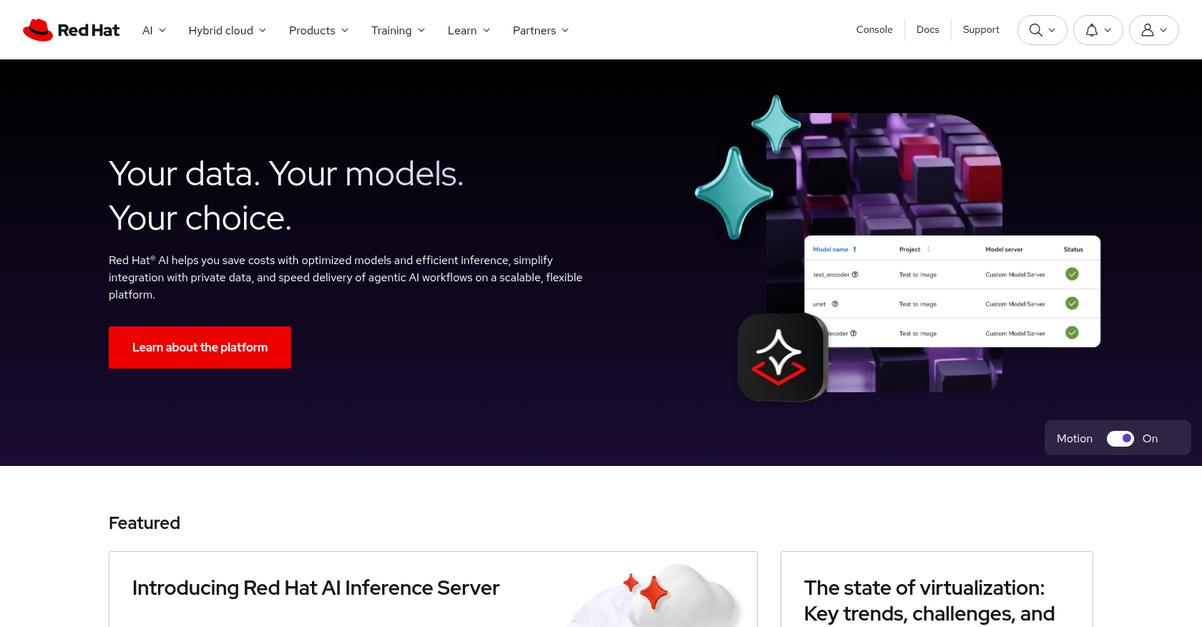
Fragmented networks making compliance and scaling difficult?
Red Hat can unify your workflows and automate processes across diverse environments. This means simplifying complex operations for your network automation needs.
Red Hat addresses these pain points by offering a broad portfolio of automation solutions. You can scale automation and unite tech, teams, and environments. This eliminates tool sprawl, ensuring consistent security policies across distributed networks.
Discover a unified execution platform.
Red Hat offers the Ansible Automation Platform, designed to implement enterprise-wide automation. This platform helps you create, manage, and dynamically scale automation across your entire organization, reducing manual effort. You can build, deploy, and monitor AI models and applications, simplifying how you manage apps from development to scaling. Additionally, its robust hybrid cloud support ensures consistency across operating environments for multi-cloud provisioning and real-time monitoring.
The result is streamlined, secure, and rapid IT service delivery.
Key features:
- Enterprise-wide automation: Red Hat Ansible Automation Platform allows you to create, manage, and dynamically scale automation across your entire enterprise, unifying disparate systems.
- Hybrid cloud innovation: Red Hat Enterprise Linux provides a flexible operating system to support application deployments from on-premise to cloud and edge environments.
- Application development and deployment: Red Hat OpenShift helps you quickly build, modernize, and deploy applications at scale, integrating seamlessly across various infrastructures.
Red Hat features, pricing, & alternatives →
Verdict: Red Hat is an excellent choice as the best network automation software for organizations struggling with fragmented systems. Its unified approach to automation through Ansible Automation Platform, coupled with robust hybrid cloud capabilities, helps cut incident resolution time by automating key processes and providing consistent security policies across your distributed network.
2. Cisco
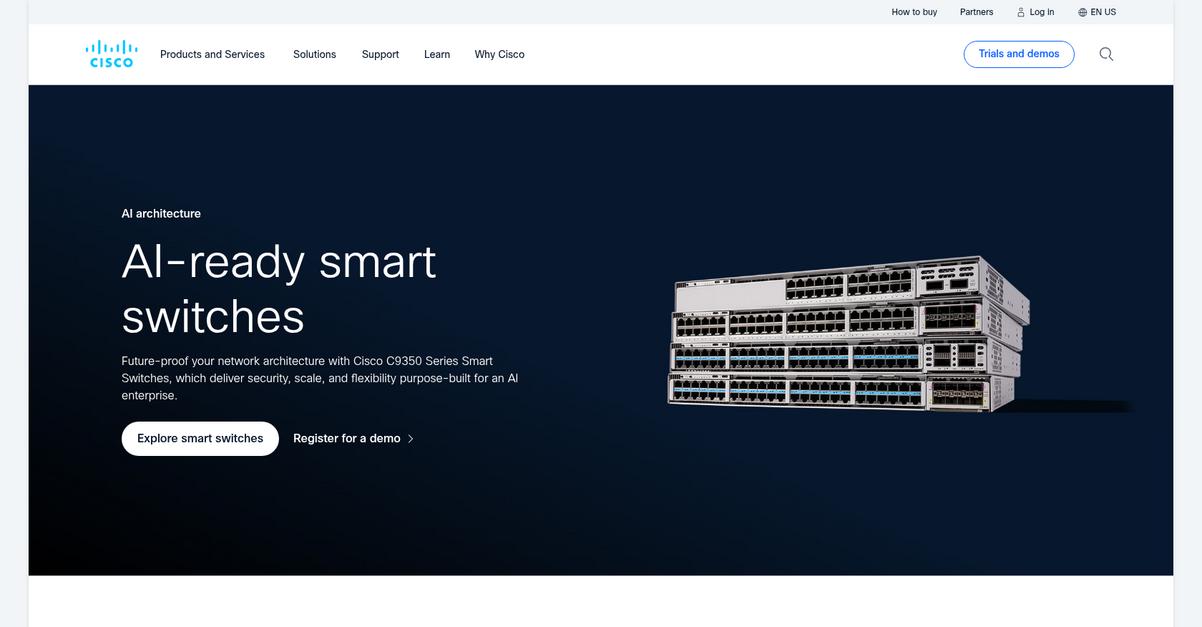
Fragmented network automation causing compliance and scaling headaches?
Cisco offers AI-ready smart switches and secure network architecture to future-proof your infrastructure. This means you can power secure AI infrastructure for the AI era.
Here’s how to transform security for the agentic AI era by fusing it into your network, helping you overcome security and scalability challenges. The result? You’ll accelerate workplace AI transformation.
Cisco helps you unify network visibility.
Their Nexus Dashboard provides end-to-end visibility across networks, GPUs, and AI tasks, helping you proactively detect issues. Plus, Hybrid Mesh Firewall provides better enforcement points for multi-vendor policies, ensuring smarter segmentation. AgenticOps brings AI Canvas to life, enabling you to deploy new Cisco Smart Switches specifically for the AI-powered enterprise. This helps deliver exceptional wireless performance, and unify views across application, infrastructure, and networking domains with Splunk and Cisco ThousandEyes integration.
It simplifies multi-cloud provisioning.
While focusing on infrastructure, businesses also consider broader growth. You might find my analysis of the best mobile marketing platform helpful for expanding your reach.
Key features:
- AI-Ready Smart Switches: Future-proof your network with security, scale, and flexibility, purpose-built for the AI enterprise and securing your infrastructure.
- Nexus Dashboard: Gain end-to-end visibility across networks, GPUs, and AI tasks for proactive issue detection and streamlined operations.
- Hybrid Mesh Firewall: Employ better enforcement points, smarter segmentation, and multi-vendor policy for robust network security and compliance.
Cisco features, pricing, & alternatives →
Verdict: Cisco’s unified approach to network, security, observability, and AI integration makes it an outstanding choice for the best network automation software, especially for organizations with multi-cloud environments. Its smart switches and comprehensive dashboards deliver the desired outcomes of reduced manual effort and improved incident response times.
3. HashiCorp
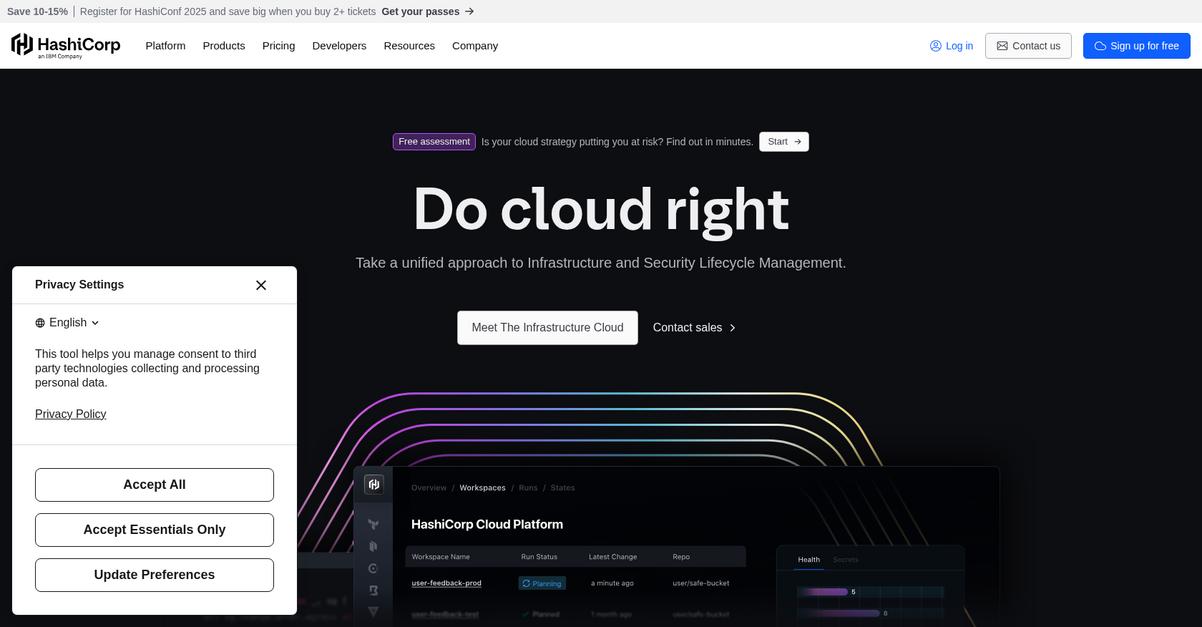
Taming network sprawl feels like an uphill battle, doesn’t it?
HashiCorp offers an Infrastructure Cloud that unifies your approach to infrastructure and security lifecycle management. This means you can provision and secure your network more efficiently.
This unified platform, powered by HashiCorp Cloud Platform (HCP), helps your organization automate the lifecycle management of infrastructure and security. It addresses the fragmentation of DIY scripts and point tools.
Time to simplify and secure your network.
HashiCorp allows you to move faster and extract more value from your cloud investments, all while ensuring proper controls are in place. This integrated suite automates the critical processes of infrastructure and security.
For infrastructure lifecycle management, Terraform allows you to provision cloud infrastructure using a common workflow, while Packer helps build and manage images as code. Nomad handles workload scheduling and orchestration, and Waypoint serves as an internal developer platform, streamlining your team’s processes.
Additionally, for security lifecycle management, Vault provides identity-based secrets management, Boundary ensures secure remote access, and Consul delivers service-based networking. These capabilities work together to protect, inspect, and connect your infrastructure, ultimately reducing risk and enhancing your overall security posture.
The result is a more cohesive and automated network.
Key features:
- Infrastructure as Code: Automate and manage all your environments using infrastructure as code for building, deploying, and managing cloud application infrastructure efficiently.
- Identity-Based Security: Utilize identity-based access controls for managing the security lifecycle of secrets, users, and services, reducing risk and improving your security posture.
- Unified Platform: Access an integrated suite of products through the HashiCorp Cloud Platform (HCP) to automate critical infrastructure and security lifecycle management.
HashiCorp features, pricing, & alternatives →
Verdict: HashiCorp is a strong contender for the best network automation software, particularly for IT directors and network architects aiming to unify fragmented ecosystems. Its suite, including Terraform and Consul, excels at automating multi-cloud provisioning and ensuring consistent security policies, directly tackling your challenges with manual effort and improving incident response.
4. NetBrain
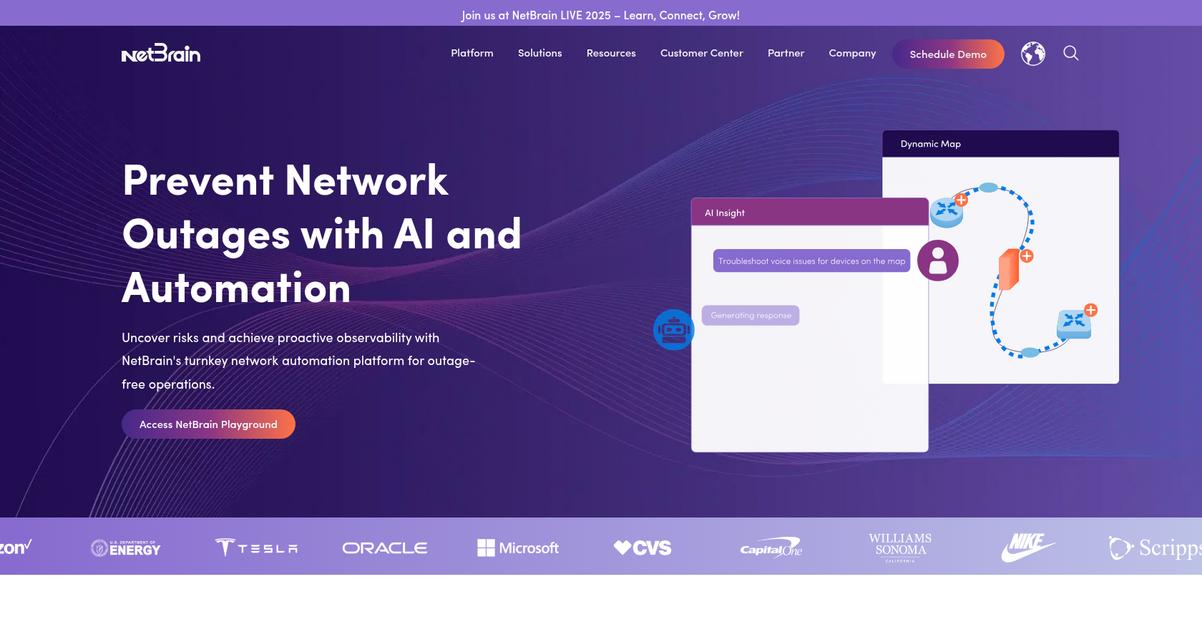
Struggling with network sprawl and reactive incident response?
NetBrain offers a turnkey platform combining Agentic AI, no-code automation, and a live digital twin, addressing your complex network challenges. This means you can overcome the reliance on fragmented DIY scripts and point tools, unifying your workflows for improved efficiency.
Your team can achieve proactive observability and prevent costly errors by analyzing change impacts at every stage. This helps minimize escalations and improves time to resolution.
Here’s how NetBrain delivers real solutions.
NetBrain tackles common pain points like fragmented network automation ecosystems with its unified approach. Its AI-assisted network troubleshooting triggers auto-diagnosis, helping you auto-close noisy tickets and providing observability of transient issues.
Additionally, NetBrain’s Triple Defense for Safe Network Change ensures network-wide observability. You can plan changes, define test plans, and execute with impact analysis, safeguarding against configuration drift. Plus, capabilities like continuous assessment and customizable dashboards with one-click auto-remediation help you maintain consistent security policies across distributed networks, essential for your multi-cloud and hybrid environments.
The result: a shift from reactive to proactive network management, cutting incident resolution time by 30% and enabling robust compliance.
Key features:
- AI-assisted Troubleshooting: Automates problem diagnosis and ticket closure, providing real-time observability of transient issues to reduce manual effort.
- No-Code Automation & Digital Twin: Enables unified workflow automation across CLI/API, simplifying complex tasks and providing a live digital replica of your network.
- Preventive & Protective Change Management: Proactively assesses networks for risks, prevents configuration drift, and ensures compliance through systematic impact analysis.
NetBrain features, pricing, & alternatives →
Verdict: NetBrain stands out as a strong candidate for the best network automation software, particularly for IT directors and network architects aiming to unify fragmented systems. Its combination of Agentic AI, no-code automation, and a live digital twin, along with features like auto-remediation and protective change management, helps you prevent outages and achieve consistent security policies across distributed networks.
5. ManageEngine
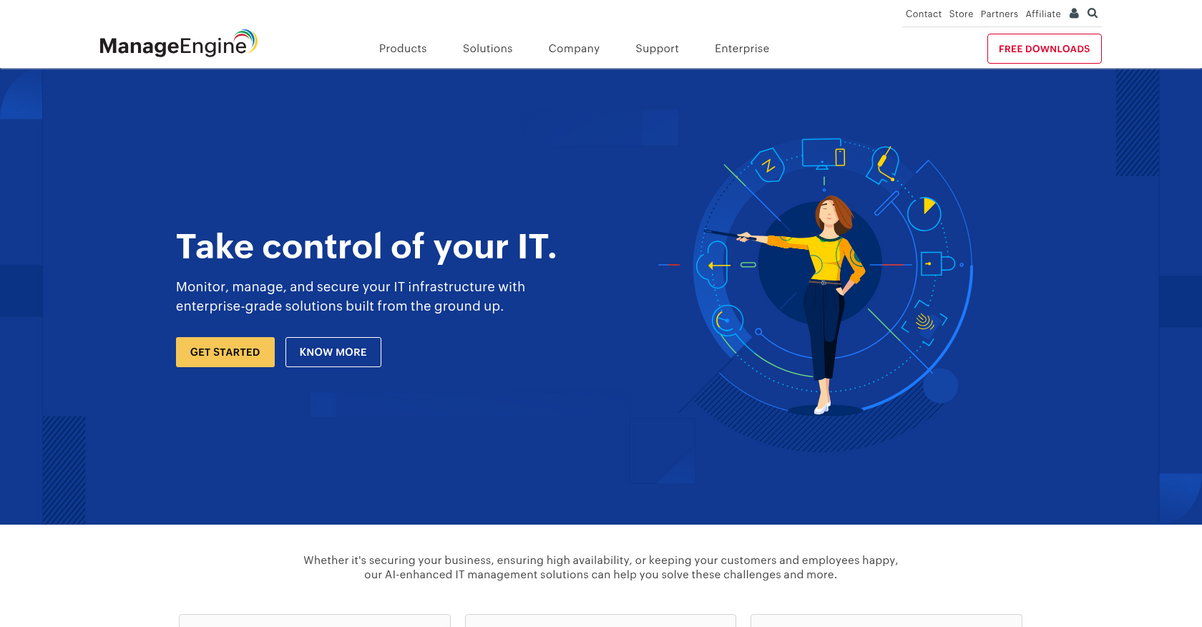
Struggling with fragmented network automation and incident management?
ManageEngine offers AI-enhanced solutions to help you monitor, manage, and secure your entire IT infrastructure. This includes robust IT Operations Management and Observability for your network.
Their platform allows you to design, automate, deliver, and manage IT and business services, tackling the challenge of fragmented tool sets and manual scripting.
This means you can finally tame your network sprawl.
ManageEngine addresses network automation pain points by providing comprehensive IT Operations Management and Observability. You can effectively monitor and manage your network, servers, and applications, consolidating your tools.
Their platform also features Security Information and Event Management to secure your network from cyberattacks and ensure compliance, which is critical for maintaining security posture across distributed networks. Additionally, with Advanced IT Analytics, you gain AI-powered insights and IT data correlation, helping you visualize IT data and plan capacity effectively. Plus, their cloud solutions support multi-cloud and hybrid infrastructures, eliminating complexity.
The result is reduced manual effort and improved incident response.
Key features:
- IT Operations Management & Observability: Monitor and manage your network, servers, and applications, providing a unified view to eliminate tool sprawl.
- Security Information & Event Management: Secure your network from cyberattacks and ensure compliance with robust log management and threat detection.
- Advanced IT Analytics & Cloud Solutions: Gain AI-powered insights for capacity planning and scale your IT across multi-cloud and hybrid environments.
ManageEngine features, pricing, & alternatives →
Verdict: ManageEngine provides robust enterprise-grade solutions for network management, making it a strong contender for the best network automation software. Its ability to unify IT operations, enhance security, and scale for multi-cloud environments, as seen in cases like LaBella Associates simplifying IT, offers rapid payback for IT directors and network architects.
6. Itential
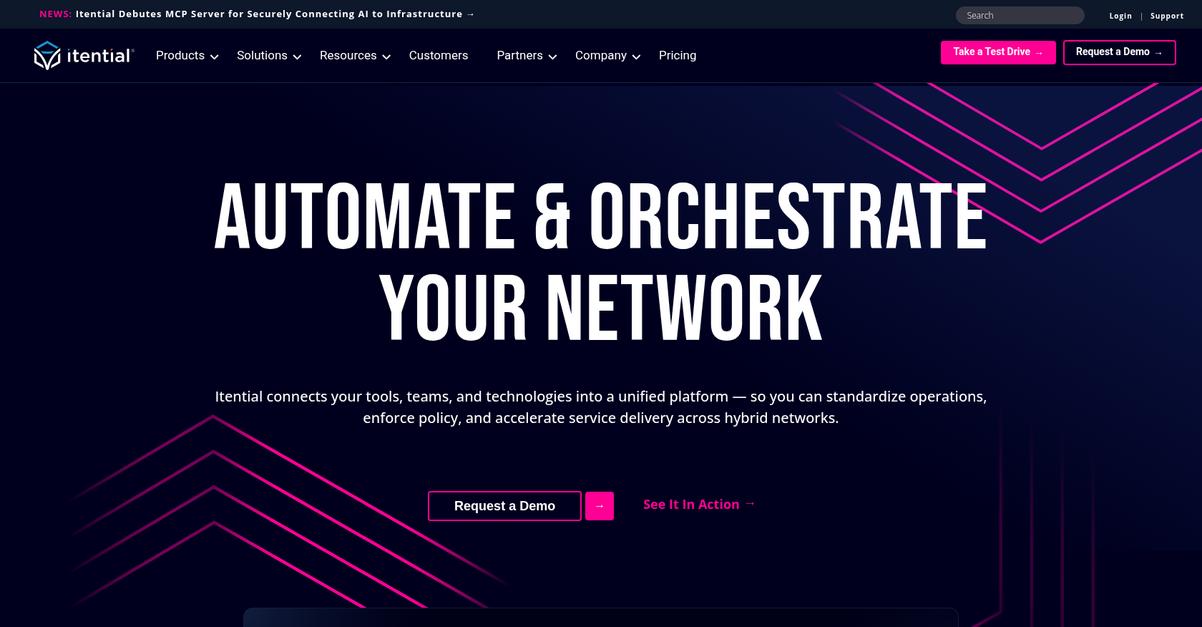
Is fragmented network automation holding you back?
Itential offers a leading SaaS platform to unify your tools, teams, and environments for streamlined network and infrastructure operations.
This means you can overcome manual provisioning, reduce error-prone processes, and eliminate inconsistent network configurations, leading to less risk and faster infrastructure changes.
Here’s how Itential transforms your operations.
Itential serves as a unified platform that connects your existing tools, teams, and technologies, standardizing operations and enforcing policies across hybrid networks.
Its high-code network automation allows you to centralize management of scripts across Python, Playbooks, and Plans, while low-code workflow orchestration empowers you to design workflows for any network change. You can also leverage self-service networking to give IT teams secure access to network resources and automate responses to event streams. This holistic approach ensures your network moves faster with less risk.
Additionally, Itential offers configuration and compliance validation, helping you manage both physical and cloud infrastructure by validating changes before they’re made. This includes pre- and post-check capabilities and dynamic Golden Configuration templates for consistent security policies across distributed networks.
The result is increased efficiency and faster service delivery.
While discussing integrations and automation, effectively designing the interfaces between systems is crucial. My guide on best API design tools offers valuable insights for development.
Key features:
- High-Code Automation: Centralize and secure your existing scripts (Python, Playbooks, Plans) with advanced authentication, authorization, and audit controls for team-wide safe execution.
- Low-Code Workflow Orchestration: Rapidly design and build vendor-agnostic workflows to automate any network change, connecting disparate IT systems and custom scripts for end-to-end automation.
- Self-Service Networking: Provide secure, unified access to network resources, enabling rapid responses to event streaming platforms and integrating with existing DevOps tools and CI/CD pipelines.
Itential features, pricing, & alternatives →
Verdict: If your organization is grappling with fragmented automation ecosystems and compliance challenges across hybrid networks, Itential is a best network automation software choice. Its ability to unify diverse tools and provide self-service options, exemplified by Fiserv’s accelerated service delivery and S&P Global’s 80-90% reduction in manual effort, directly addresses complex pain points and significantly improves incident response.
7. IP Fabric
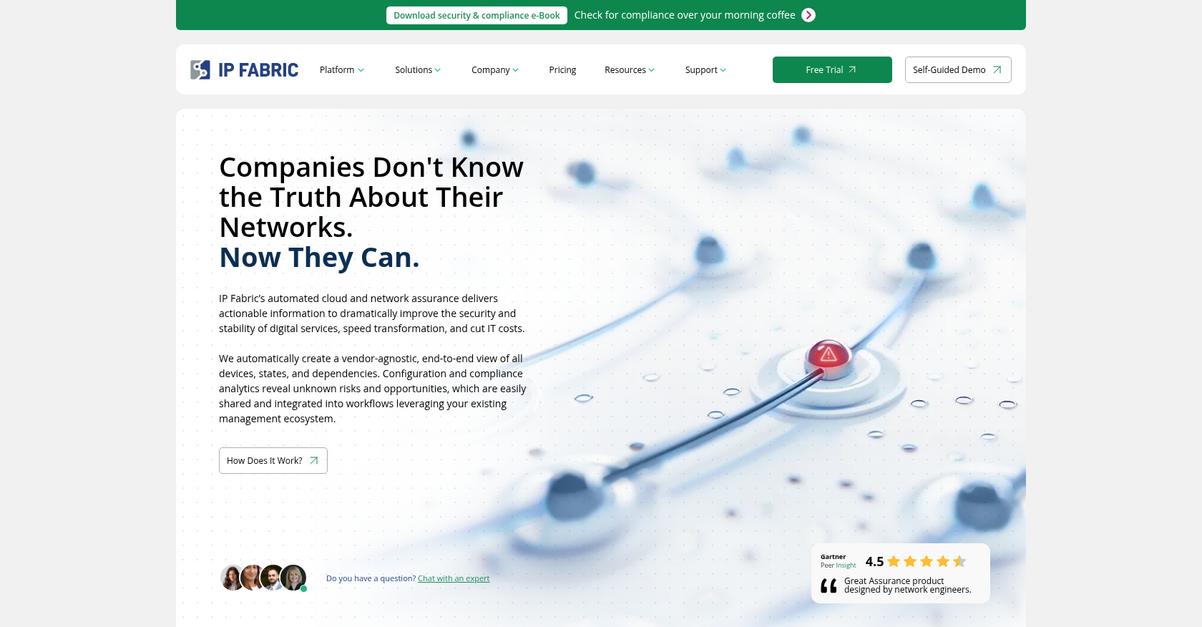
Are network automation silos complicating your operations? This challenge is especially true for IT directors and network architects managing fragmented ecosystems. IP Fabric directly addresses this by providing a unified, end-to-end view of your network, cloud, devices, states, and dependencies.
This means you can replace those disjointed DIY scripts and point tools, giving you a centralized source of truth. IP Fabric automatically discovers critical vulnerabilities and compliance problems, allowing your team to proactively identify and resolve issues. The result is improved security, stability, and lower IT costs.
Here’s how IP Fabric solves your network challenges. This solution unifies insights from your entire estate.
IP Fabric delivers 100% accurate, vendor-agnostic insights, far exceeding what traditional monitoring or inventory tools offer. It securely discovers your network via SSH, building a customized model of your intent. This unique approach allows for continuous validation against your ideal network state, flagging issues like inconsistent firewall configurations or segmentation gaps. Additionally, it helps you populate ITSM tools with end-to-end path lookups, drastically lowering your Mean Time to Resolution (MTTR) by up to 40%. You can also fill dangerous data gaps in your existing tools and speed up root cause discovery.
You gain powerful control over your network.
Before diving deeper, you might find my analysis of demo automation software helpful for improving your sales cycle.
Key features:
- Centralized Visibility: Delivers a 100% accurate, vendor-neutral view of your entire network and cloud environment, identifying vulnerabilities and policy compliance issues often missed by other tools.
- Configuration & Change Validation: Creates network compliance checks that alert you to any drift from your intended network state, ensuring consistent security and performance.
- Closed-Loop Automation: Provides standardized, accurate data for automation initiatives, enabling secure and scalable workflows while validating that changes happen as intended.
IP Fabric features, pricing, & alternatives →
Verdict: IP Fabric is an excellent choice for organizations seeking the best network automation software to unify workflows and enhance compliance. It helps you de-risk strategic initiatives, reduces manual effort by up to 90% for automation projects, and cuts incident resolution time by up to 40%.
8. BackBox
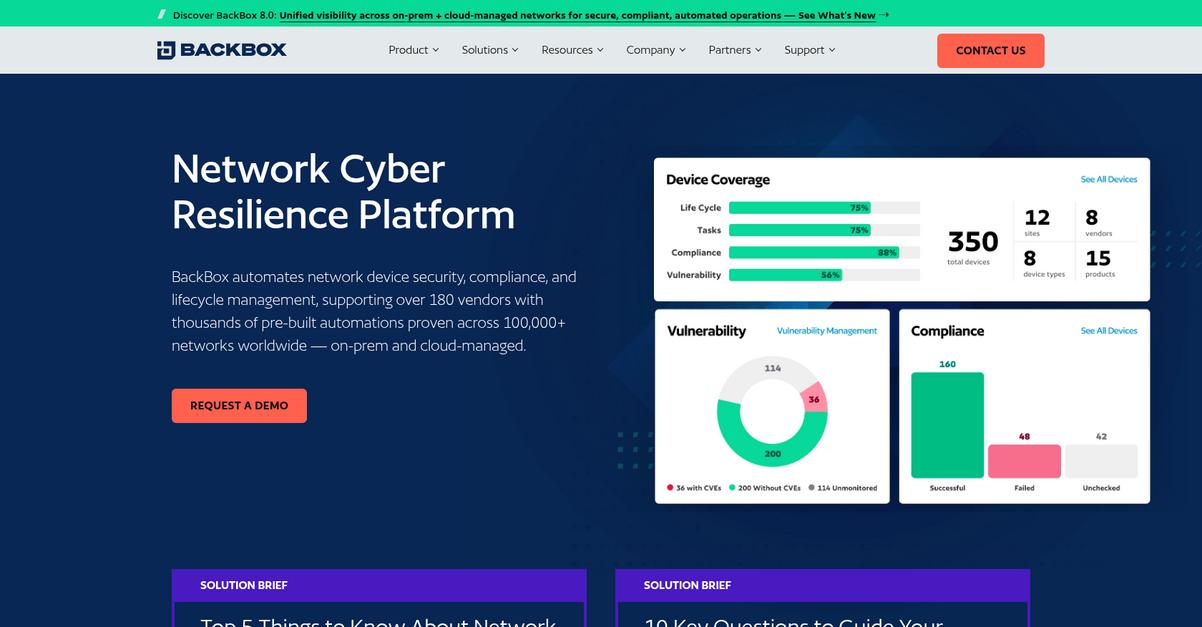
Struggling with network sprawl and manual processes?
BackBox centralizes network device security, compliance, and lifecycle management across your diverse network.
This means you can tame your fragmented network automation ecosystem and ensure your devices are always in a trusted state.
Here’s how to simplify operations.
BackBox offers unified visibility across both on-premise and cloud-managed networks, streamlining your operations.
It provides out-of-the-box support for over 180 vendors and thousands of devices, ensuring seamless integration into your existing environment.
Additionally, BackBox features a no-code automation capability, allowing you to create and deploy automations quickly without scripting. Plus, with over 3,000 pre-built automations, you can enhance efficiency from day one, significantly reducing manual effort.
The result is greater cyber resilience.
Key features:
- Unified Visibility: Gain comprehensive insights across on-premise and cloud-managed networks, ensuring secure and compliant automated operations.
- Multi-Vendor Support: Seamlessly integrate with over 180 vendors and thousands of devices using thousands of pre-built automations proven across 100,000+ networks.
- No-Code Automation: Simplify and accelerate the creation and deployment of automations without requiring scripting knowledge, freeing your teams for strategic work.
BackBox features, pricing, & alternatives →
Verdict: BackBox offers unified visibility, multi-vendor support, and no-code automation, making it a compelling choice for best network automation software. Its extensive pre-built automation library and focus on cyber resilience will significantly reduce your manual effort and improve incident response, cutting what used to take weeks to mere hours.
9. VMware
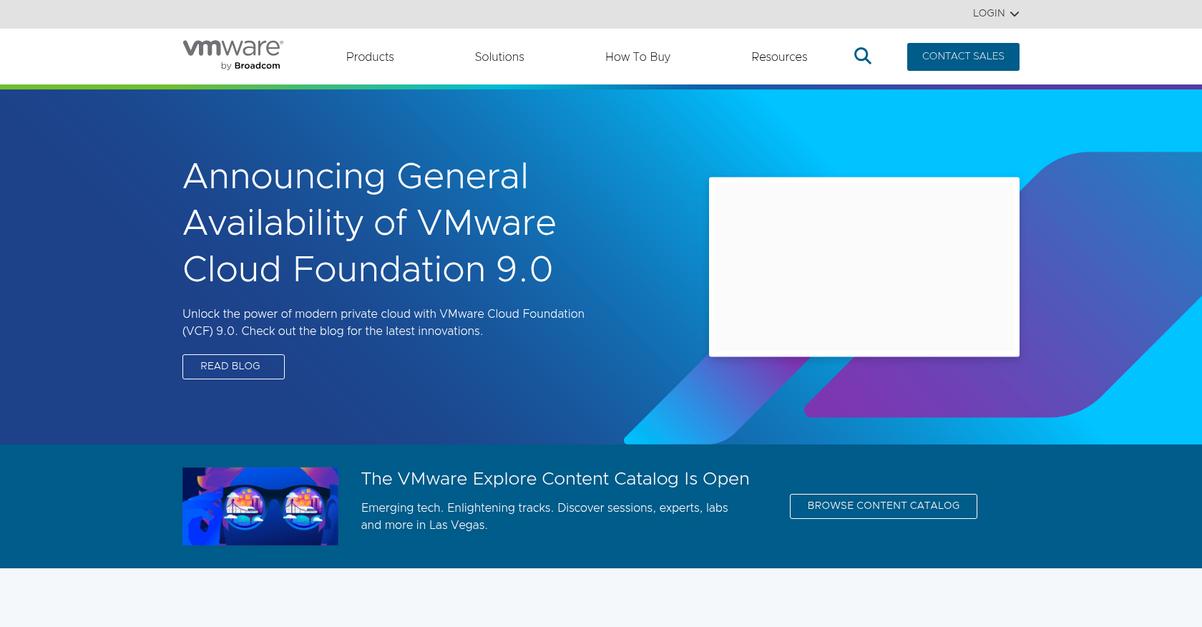
Is your network automation becoming a complex mess?
VMware offers solutions to simplify this, providing a unified approach across your diverse infrastructure. This means your team can achieve greater operational efficiency.
You might be grappling with fragmented tools and struggling to maintain consistent security policies. VMware aims to centralize control, making compliance and scaling more manageable across your distributed networks.
Here’s how to tame network sprawl.
VMware helps unify workflows, removing reliance on disparate DIY scripts and point solutions. This allows your organization to automate multi-cloud provisioning and streamline operations.
Its capabilities address the challenges of integrating with existing systems like ServiceNow, ensuring seamless adoption. You can maintain consistent security policies across hybrid and multi-cloud environments, enhancing your security posture.
Additionally, VMware provides real-time monitoring and aims to cut incident resolution time by supporting simplified infrastructure management. This consolidates disparate tools, eliminating tool sprawl for a more cohesive network automation strategy and faster response.
Achieve consistent security and faster response.
While focusing on streamlining operations, effective communication is also crucial. My article on best virtual meeting platform explores options for secure collaboration.
Key features:
- Unified network management that centralizes control across multi-cloud and hybrid environments, reducing the complexity of fragmented automation ecosystems.
- Automated multi-cloud provisioning to streamline the deployment of resources, ensuring consistent configuration and security across distributed network infrastructures.
- Real-time monitoring capabilities that provide immediate insights into network performance, helping your team quickly identify and resolve incidents to improve response rates.
VMware features, pricing, & alternatives →
Verdict: If your team is seeking the best network automation software to unify disparate workflows and achieve consistent security policies, VMware offers a compelling solution. Its focus on simplifying infrastructure management and improving incident response makes it a strong contender for large organizations.
Conclusion
Network sprawl shouldn’t be your normal.
I get it. Your mix of DIY scripts and siloed point tools makes choosing a truly unified automation solution feel nearly impossible for your IT team.
The impact is huge. Forrester found organizations see a 30-50% reduction in operational costs by adopting network automation. That’s a massive boost to efficiency, freeing up your team for more strategic work.
Here’s what I recommend.
After reviewing all the options, Red Hat is my top pick. It directly addresses the fragmentation by unifying your workflows and finally ending the tool sprawl.
I love its Ansible Automation Platform for scaling enterprise-wide. It’s the best network automation software for creating a single, consistent system that finally tames your complex environment.
Speaking of taming complex environments, ensuring data integrity is crucial. My guide on blockchain analysis tools can help with fraud detection and compliance.
I highly recommend you start a free trial of Red Hat. See for yourself how it can unify your complex operations and boost your team’s output.
Your incident response will quicken significantly.






